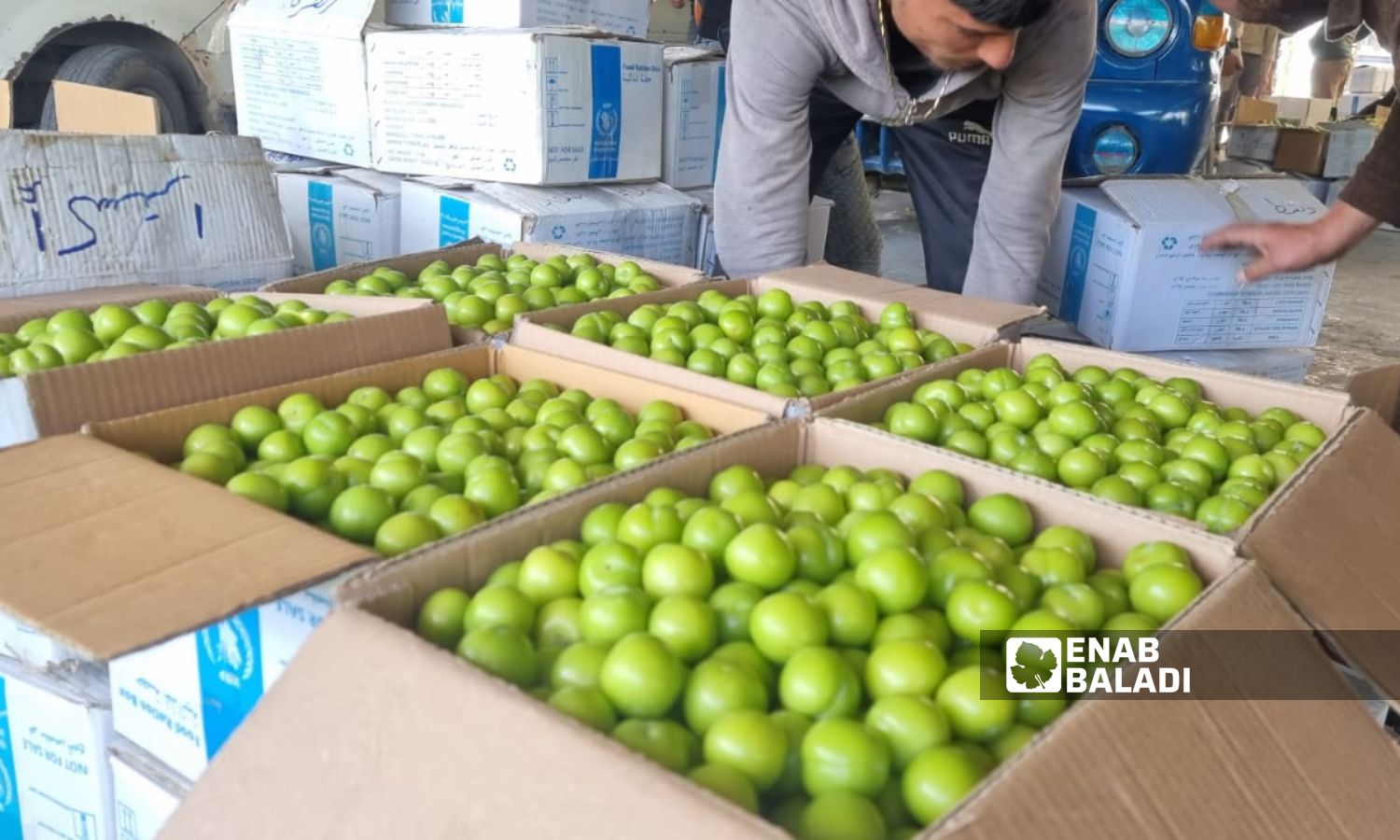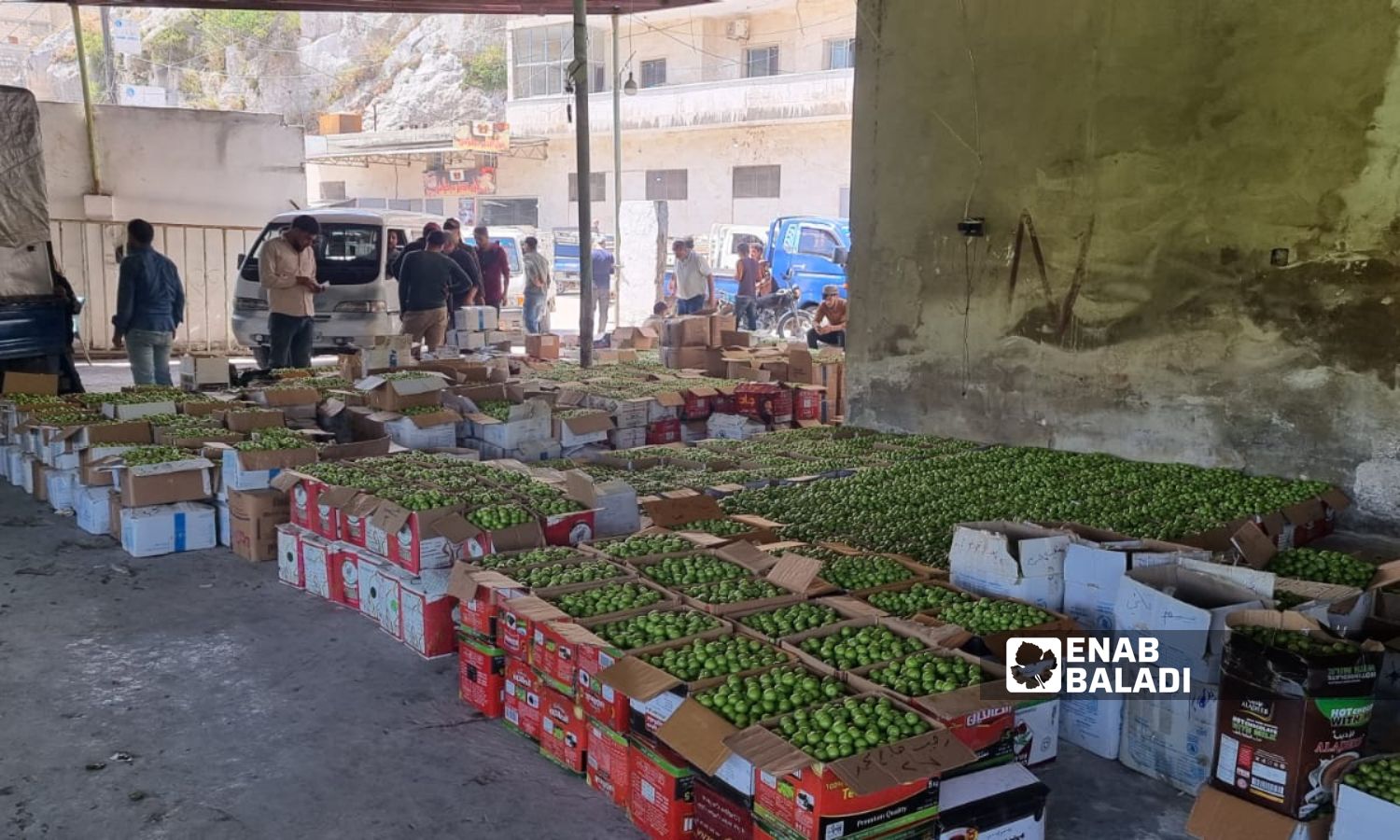



Idlib – Anas al-Khouli
Every morning, Khalil Koshli loads up the green plum fruits from his land in Darkush, West of Idlib, and heads to the local wholesale market, hoping to sell his harvest at a decent price that covers production costs and yields profits sustaining a “decent” life for his family.
The farmer owns 30 dunams planted with green plums, figs, and grapes in the Mazra area along the Syrian-Turkish border. He mentioned that crop prices have improved this year due to the possibility of exporting abroad.
He noted that the Gulf States, Iraq, and Lebanon are primary markets for green plum fruits. He pointed out that export doors were closed in previous years, thus farmers relied on domestic markets to sell their produce.
Green plums is an active crop in the Darkush area, heavily relied upon by the residents for livelihood. They are hopeful about this season after consecutive losses in past years due to the lack of external markets.
Green plums is a spring fruit consumed with salt, providing a sour taste and has a short season lasting only two months. This short period prompts citizens to quickly purchase it, making its trade relatively short-lived.
Safwan Abdul Karim (40 years old), a merchant at the market, sells the agricultural production on “trust”; he keeps the farmers’ produce in his shop and sells it according to an agreed percentage with the farmer.
Abdul Karim told Enab Baladi that this year’s green plums season is better than previous ones since the production is good and the prices are “very suitable” for everyone, whether it’s farmers, consumers or even traders working on exporting the production.
He mentioned that the green plum fruit has various types, the best being “al-Zahra” characterized by its large size, with the price of a kilogram reaching up to 3 US dollars, followed by the second type at two dollars, and the third type ranging between 50 cents to one dollar, and finally, “al-Awir”, the lowest type at 20 cents per kilogram.
The exchange rate of the Turkish lira against the dollar was 32 for selling and 32.5 for buying, according to the Union of Money Changers pricing in Idlib region.
The trader explained that prices are better this year, generating financial returns for farmers, due to the possibility of exporting goods to neighboring countries through the Bab al-Hawa border crossing with Turkey, and from there to other countries.
According to the trader, the average price of a kilogram of green plums in international markets is 7 dollars, attributing the low local prices compared to international markets to the high export costs borne by traders.

Idlib’s western countryside areas are known for the cultivation of green plums – May 15, 2024 (Enab Baladi/Anas al-Khouli)
Before each season, farmers complain about the short agricultural season of green plums and the high costs, including transport, fertilizers, and insecticides, as they need to spray the trees four times a year.
One of the problems or obstacles is the invasion of wild boars into the lands, as they break trees and damage crops, according to farmer Khalil who spoke to Enab Baladi, especially since his land is near the Turkish-Syrian border.
Khalil and the farmers in the area cannot carry weapons or guard their lands from these animals due to the proximity of the border and the presence of military units near the lands, which could cause problems with those units.
The farmer’s land produces 700 kilograms of green plums daily, needing ten workers to help harvest the fruits, with each worker’s wage being 150 Turkish liras.
Additionally, there are transport costs as the farmer needs to move the fruits from the land via an agricultural tractor due to the rough terrain, then by a transport vehicle to the market, plus the cost of the empty carton in which the fruits are placed, costing 10 Turkish liras each.
The farmer mentioned that farmers incur considerable amounts for watering the trees throughout the year, varying depending on the distance of the trees from the water well, plus the costs of spraying pesticides which cost 50 dollars per spraying operation.
A number of farmers interviewed by Enab Baladi have asked the responsible authorities to help them find solutions to the wild boar problem.
Boars are disliked by the residents of northern Syria, and their presence raises fears of disease spread.
People from Darkush told Enab Baladi that these animals are prevalent in Hama and the coastal forests of Syria, attributing their appearance in the area to overhunting in those regions and to repeated bombings by the regime forces on the front lines, and to frequent fires in those forests.
if you think the article contain wrong information or you have additional details Send Correction